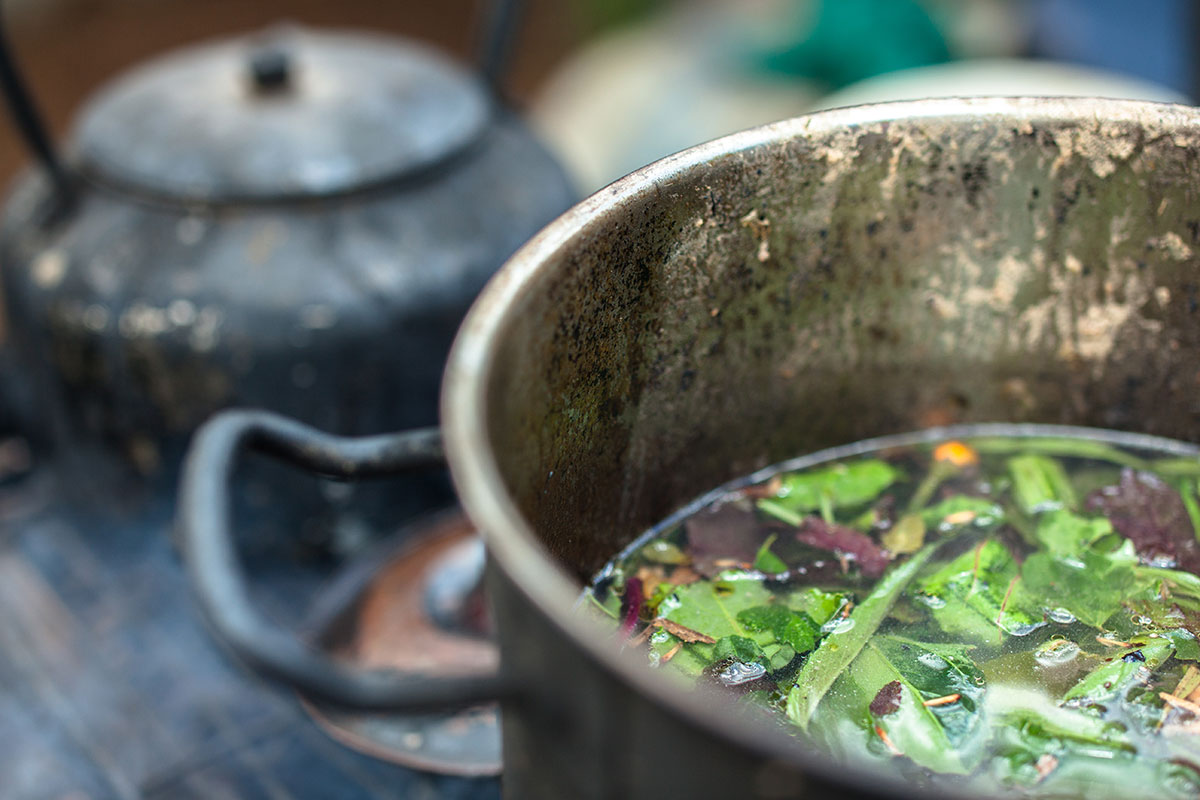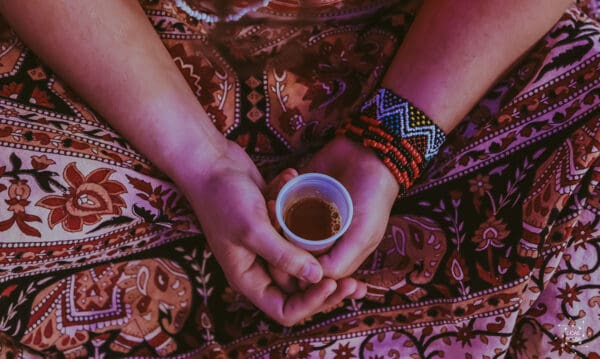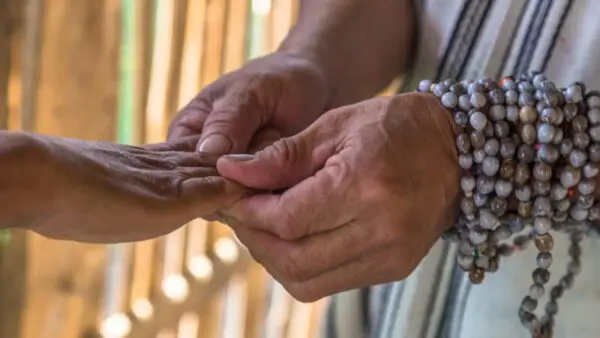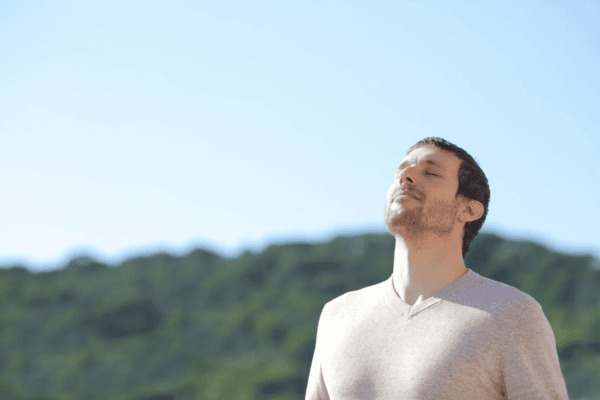Medical Editor: Dr. Benjamin Malcolm, PharmD, MPH, BCPP
Mainstream media sometimes uses the terms ayahuasca and DMT interchangeably, but they are not the same thing. While DMT is a crucial ingredient in ayahuasca, its effects are quite different, particularly in experience intensity and duration. Research suggests that both show promise or are being investigated for a variety of conditions. Let’s walk through them and discuss how they are similar and different.
Ayahuasca vs DMT – What is the Difference?
N,N-dimethyltryptamine (DMT) is a simple and potent psychedelic molecule found in many plants, such as psychotria viridis (chacruna) and diplopterys cabrerana (chaliponga), as well as animals. While DMT is naturally produced in the human brain, they are still working to understand the purpose of the molecule and much myth surrounds it, such as significant secretion by the pineal gland.
DMT can cause intense perceptual, cognitive, and emotional changes. In its base form, DMT is usually vaporized and used via inhalation, although can also be injected. When used by these routes of administration it has a much shorter duration of action than ayahuasca.
Typically, ayahuasca is a brew of two plants, one of which contains DMT, while the ayahuasca vine contains harmala alkaloids or monoamine oxidase inhibitors (MAOIs). Therefore, ayahuasca may be chemically reduced to DMT + MAOIs taken by mouth, while DMT is typically used via inhalation without MAOIs.
Indigenous people in countries like Colombia and Peru have been using ayahausca for hundreds of years as medicine and for religious worship. Compared to the intense and short-lived experience of pure DMT, an ayahuasca trip lasts for a few hours.
Many Westerners seeking psychedelic medicine travel to countries such as Brazil or Peru where ayahuasca is legally available. In this setting, ritual experiences are often embedded within a longer retreat. For example, the tea is often consumed on multiple nights with healing and integration work done during the day when taken as part of an ayahuasca ceremony or retreat.
Why Does Ayahuasca Last So Much Longer Than Smoked DMT?
Normally, DMT is broken down before it can be absorbed, thus pure DMT has no effect when taken by mouth. For this reason, it is usually used by inhalation. When inhaled or smoked, DMT goes directly into the bloodstream through the lungs and the total experience lasts 10-20 minutes.
Ayahuasca is ingested by mouth and absorbed through the gut, which produces an experience that usually lasts four to six hours. It is due to the MAOIs in the ayahuasca vine that DMT can reach circulation and provides the person with the longer and more drawn-out psychedelic experience characteristic of ayahuasca.
Ayahuasca vs. DMT Ingredients
The recipe for ayahuasca can vary from brewer to brewer. Generally, ayahuasca is made by boiling down the plants used for at least eight hours in a process called decoction. The process of adding water and boiling it down may be repeated several times. The variability in the plants used, their concentrations of active ingredients, and the brewing process makes each batch of ayahuasca slightly different.
The traditional recipe for ayahuasca contains two ingredients: the banisteriopsis caapi (ayahuasca) vine and psychotria viridis leaf. The ayahuasca vine has monoamine oxidase inhibitors or MAOIs.
While DMT is the psychedelic substance responsible for the ‘visions’ sometimes discussed with ayahuasca, the MAOIs have psychoactive effects and many traditional cultures regard the vine as being very healing. It is the MAOI-containing vine that is known as the ayahuasca vine after all.
One study suggests that an MAOI in ayahuasca can stimulate brain growth and pharmaceutical MAOIs are known to be helpful for depression. While they play a crucial role in the psychedelic therapy provided by ayahuasca, people seeking treatment should make sure that they aren’t on medication that interacts with MAOIs (such as Lithium, SSRI antidepressants, stimulants, and others). MAOIs can also be dangerous when used with excessive amounts of fermented or tyramine-containing foods.
How is DMT Different from Ayahuasca?
The biggest differences between ayahuasca and DMT involve the duration and intensity of experience and routes of administration, which is discussed above. There may be less healing potential when use of pure DMT if indeed the MAOIs in the ayahuasca vine provide therapeutic effects. From the perspective of drug interaction risks, DMT has lower risks than ayahuasca because it does not contain MAOIs. Some people believe that DMT is produced during death and divine experiences, which may be where it got its nickname the “spirit molecule,” coined by Rick Strassman, psychiatrist and author of DMT – The Spirit Molecule: A Doctor’s Revolutionary Research Into the Biology of Near-Death and Mystical Experiences.
The Ayahuasca Experience
While it’s legally available in two U.S. churches (UDV and Santo Daime) many people travel to South America to take part in an ayahuasca ceremony, which is led by an ayahuasca facilitator, sometimes termed a curandero(a) or shaman. Ayahuasca is traditionally drunk at night, participants collectively gather in the ceremony space to drink the sacred brew. The facilitator usually sings healing songs or ‘icaros’ or plays music that helps to guide the person’s experience, open spiritual worlds, or have specific healing effects for persons.
Ayahuasca takes 20-60 minutes to kick in
Ayahuasca takes about 20 to 60 minutes to take effect. Ayahuasca is notorious for physical effects and is commonly known as “the purge” or la purga. Vomiting, diarrhea, gas, crying, screaming, sweating and shaking can all occur and are traditionally considered to be part of the purge and may feel cathartic to people.
The indigenous traditions that ayahuasca comes from regard the purge as a healthy and normal part of the journey. Some ayahuasca drinkers believe that the purge can assist in letting go of anxiety, ego, fears, and any behaviors holding the person back from living as their true self.
Ayahuasca should be taken with supervision
During the early stages of an ayahuasca trip, people may report swirling color trails, geometric visuals, and other psychedelic effects which may grow in intensity until the experience peaks. People often report being met with a “mirror” — a harsh but helpful view of oneself, flaws and all. A willingness to let go or avoid mentally resisting the experience is thought to be crucial to beneficial experiences and underscores the need to use in an environment the person fully trusts.
The potential for vomiting or other extreme physical effects, overwhelming and intense psychological effects, and added safety of well-run ceremonial settings are all reasons that it’s generally advised to use ayahuasca with the supervision of a well-trained facilitator, at least initially.
Unfortunately, facilitators that take advantage of vulnerability including activities such as sexual assault is not uncommon and persons should thoroughly vet facilitators and assistants prior to engaging in ayahuasca ceremonies with them
Ayahuasca may activate repressed memories
Research suggests that ayahuasca can also activate repressed memories, which is one of the reasons why it’s being studied as a psychedelic therapy for PTSD or depression.
Some people report working through memories or traumatic experiences have come out on the other side with a healthier and new perspective, while other report experiences that were terrifying and felt they were more deeply traumatized because of it.
The DMT Experience
When consumed (typically inhaled) in its raw chemical form, DMT brings up a quick and potentially ultra-intense psychedelic experience.
DMT takes 10-20 minutes to kick in
The effects take hold almost instantly, peak within two minutes, and are completely gone within 10 – 20 minutes. While using small doses can result in relatively subtle effects, inhaled DMT is notoriously used in larger doses to obtain a ‘breakthrough’ experience.
In breakthrough DMT experiences, the person is often transported into another dimension characterized by highly intricate geometric fractals and encounters with spirits, aliens, or other entities. These effects were famously documented in the book, The Spirit Molecule, by the aforementioned psychiatrist and psychedelic researcher Rick Strassman. He describes results from studies he conducted in persons that used intravenous DMT, in which about half of the volunteers reported experiences that felt like entering other planes or dimensions – complete with aliens, elves, guides, gods, and other non-human entities.
Compared to psychedelics like psilocybin or 5-MeO-DMT which may produce ego dissolution and ‘non-dual’ experiences, the subject-object relationship (duality) is typically preserved with inhaled DMT.
DMT can be taken more casually than ayahuasca
Whereas ayahuasca is usually taken as part of a ceremony in which persons undergo serious preparation and approach with spiritual reverence, many people use DMT in much more casual settings. The brevity of the experiences is how DMT was nicknamed “the businessman’s trip,” for the fact that the person can have an experience and be back to their normal waking consciousness in under an hour. It is strongly cautioned against using DMT without preparation, a well thought out set, and setting, or without supervision.
DMT may cause intense physical and emotional effects
High doses of DMT can seriously compromise a person’s ability to move. Some people vomit during the throes of a DMT trip. Use by inhalation may mean there are hot items nearby the person. Not to mention the incredible intensity can induce intense fears and result in traumatization when the person is not well prepared.
Ayahuasca vs. DMT Summary and Conclusions
While it may not be inaccurate to consider ayahuasca as a ‘form of DMT’ there is much more to the brew due to other ingredients and MAOIs found in the ayahuasca vine.
Beyond chemical differences, the two experiences differ by route of administration, duration, and intensity of effects. While ayahuasca has a strong historical tradition as a healing medicine or religious sacrament, inhaled or injected DMT is a relatively new phenomenon with much less history and research backing beneficial effects.
For these reasons, ayahuasca may be more appropriate for those seeking healing and connection through ceremony, while DMT may be more appropriate for people seeking psychonautic exploration of psychedelic worlds.








